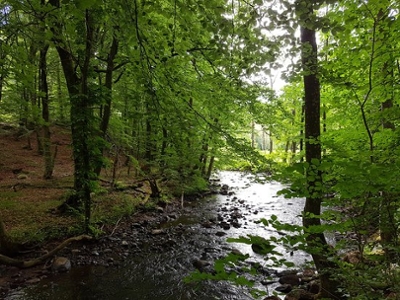Forest management impacts on stream integrity at varying intensities and spatial scales: Do abiotic effects accumulate spatially?
Author: Erdozain M., Kidd K.A., Emilson E.J.S., Capell S.S., Kreutzweiser D.P., Gray M.A.
Posted on Mar 12, 2021
Category: Research , Publications
Abstract: Though effects of forest harvesting on small streams are well documented, little is known about the cumulative effects in downstream systems. The hierarchical nature and longitudinal connectivity of river networks make them fundamentally cumulative, but lateral and vertical connectivity and instream processes can dissipate the downstream transport of water and materials. To elucidate such effects, we investigated how a suite of abiotic indicators changed from small streams to larger downstream sites (n = 6) within three basins ranging in forest management intensity (intensive, extensive, minimal) in New Brunswick (Canada) in the summer and fall of 2017 and 2018. Inorganic sediments, the inorganic/organic ratios and water temperatures significantly increased longitudinally, whereas nutrients and the fluorescence index of dissolved organic carbon (DOC; indication of terrestrial source) decreased. However, some longitudinal trends differed across basins and indicated downstream cumulative (inorganic sediments, the inorganic/organic ratios and to a lesser extent DOC concentration and humification) as well as dissipative (temperatures, nutrients, organic sediments) effects of forest management. Overall, we found that the effects previously reported for small streams with managed forests also occur at downstream sites and suggest investigating whether different management practices can be used within the extensive basin to reduce these cumulative effects.
Authors:
Author affiliations:
1 Canadian Rivers Institute and Biology Department, University of New Brunswick, 100 Tucker Park Road, Saint John, New Brunswick E2L 4L5, Canada.
2Department of Biology, School of Earth, Environment and Society, McMaster University, 1280 Main St. W., Hamilton, Ontario L8S 4K1, Canada.
3 Natural Resources Canada, Canadian Forest Service, Great Lakes Forestry Centre, 1219 Queen St. East, Sault Ste. Marie, Ontario P6A 2E5, Canada.
4 Canadian Rivers Institute, Faculty of Forestry and Environmental Management, University of New Brunswick, 28 Dineen Drive, Fredericton, New Brunswick E3B 5A3, Canada.
To read the entire article go to doi: 10.1016/j.scitotenv.2020.141968

